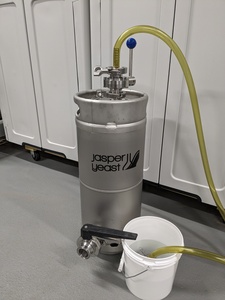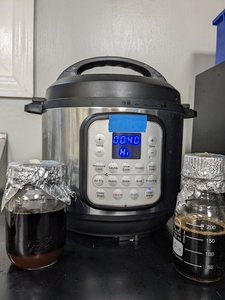Troubleshooting- Casting Out at the Right Temperature and closing off your lowest glycol jacket
You're brewing a lager, but your glycol chiller is underpowered and you can't cast out into the fermenter below 60F. This is not ideal. Here's why.
Your lager tastes great when fermented at 52F, but your brewery's chiller isn't properly sized for your batch size. You've finished casting out and the wort in your FV is sitting at 62F. You now rely on your FV jackets to slowly bring the temperature down to the proper temperature. Keep in mind that your glycol batch is usually set below freezing, at 28-30F. When pulling down the temperature in your tank, portions of your wort will be much cooler than your set point in order to fully bring down the average temperature of the entire batch. With the jackets constantly on for several hours, it's likely that a significant portion of your yeast pitch will drop out of suspension. Cold temperatures work against active fermentation, and yeast activity is needed to help keep the yeast in suspension by releasing CO2. If you can cast out into your FV at, or slightly below fermentation temperatures, it's likely you will have significantly improved yeast performance and reduced lag time by allowing the relative temperature in the tank to rise, rather than fall. This warming, from 50F to 55F, for example allows the yeast to more easily resuspend itself. Your tank will not require any 28F glycol cooling until well into active fermentation.
Keep in mind the height difference from the temperature probe, all the way down to the bottom of the tank. If the tank is set at 52F, it's very likely the bottom of the tank several feet below, is several degrees cooler than your FV set point. We have measured liquid form the bottom of a tank as much as 6 degrees cooler than the temp at the height of the probe. For this reason, we highly recommend adding a valve to the inlet on your bottom glycol jacket. Close this valve during fermentation to avoid excessively cooling your batch during fermentation. If you have the top jackets on and leave the bottom jacket closed, you'll see a more even temperature in the tank, and this will encourage circulation in the tank. This way, you are cooling the warmest section of the FV, rather than equally cooling the warmer and relatively cooler sections at the same rate. This is a great tip for lager fermentation, but also helpful for ales as well. Once you're ready to crash cool your tank, you can open up the bottom jacket as well. You can easily add an additional valve by closing off the main supply to that tank, draining the jacket until it's below the level of the bottom jacket inlet, and then thread on the new valve.
Keep in mind the height difference from the temperature probe, all the way down to the bottom of the tank. If the tank is set at 52F, it's very likely the bottom of the tank several feet below, is several degrees cooler than your FV set point. We have measured liquid form the bottom of a tank as much as 6 degrees cooler than the temp at the height of the probe. For this reason, we highly recommend adding a valve to the inlet on your bottom glycol jacket. Close this valve during fermentation to avoid excessively cooling your batch during fermentation. If you have the top jackets on and leave the bottom jacket closed, you'll see a more even temperature in the tank, and this will encourage circulation in the tank. This way, you are cooling the warmest section of the FV, rather than equally cooling the warmer and relatively cooler sections at the same rate. This is a great tip for lager fermentation, but also helpful for ales as well. Once you're ready to crash cool your tank, you can open up the bottom jacket as well. You can easily add an additional valve by closing off the main supply to that tank, draining the jacket until it's below the level of the bottom jacket inlet, and then thread on the new valve.

Stay in the know
Sign up for our newsletter now and hop into the world of brewing excellence.
Related Posts

How to maintain high viability in stored yeast
2023-07-05 22:33:56 UTC
By: Travis Tedrow
Congrats! You have successfully harvested yeast into your brink. Now we will outline the best practices for feeding and storing your yeast to ensure the highest possible viability.

How to DIY your own Yeast Feeders
2023-08-08 04:17:11 UTC
By: Jasper Akerboom
We ship a small bottle of autoclaved media to feed yeast pitch for every order. Below we'll detail how you can make your own yeast feeders with wort from your kettle.
